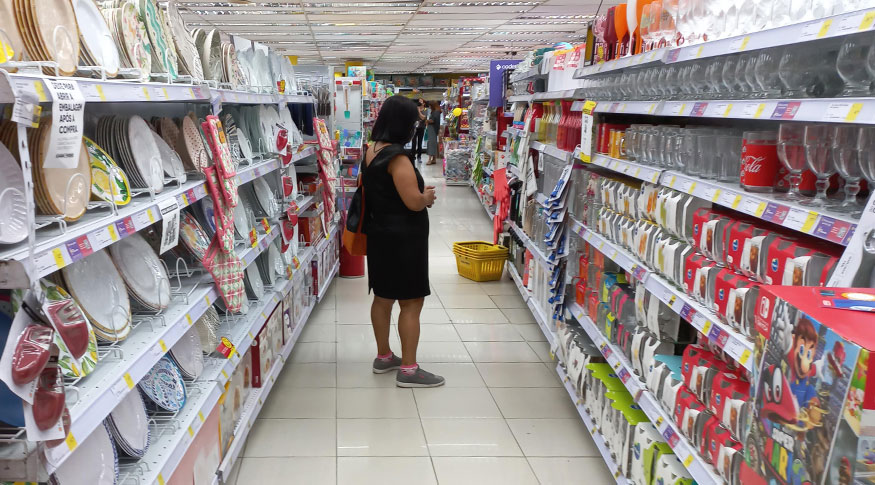Monthly Survey of Trade
Retail sales up 1% and close Q1 on the rise
May 10, 2022 09h00 AM | Last Updated: May 12, 2022 07h40 PM

The sales volume of the retail trade in Brazil grew 1.0% in March, compared to February, being the third monthly high in a row. March had increase of 4.0% against the same month last year. Thus, the sector closes the first quarter with rise of 1.3% in comparison with the some period in 2021. These results are from the Monthly Survey of Trade, released today (May 10) by the IBGE.
In extended retail trade, which includes, besides retail, the activities of vehicles, motorcycles, parts and pieces and construction material, the sales volume increased 0.7% against February.
For survey manager Cristiano Santos, the third high in a row calls the attention since something similar had happened long ago, in May/October 2020 (five months in a a row), when trade recovered from the great losses recorded at the Covid-19 pandemic peak.
“The trend had been oscillating, irregular. Those three months of highs indicate a strong quarter, although the growth was not the same for all the activities”, he explains. In March, the sector stood 2.6% above the pre-pandemic level, of February 2020. Extended retail recorded 1.7%. However, Mr. Santos highlights that the recovery is still no spread over the activities, since six sectors are below the pre-pandemic level, and four are above, considering the extended retail.
From February to March, six of the eight activities increased. The highlight is to the performance of office, computer and communication equipment and material and to other articles of personal and domestic use, with highs of 13.9% and 3.4%, respectively. The latter, according to Mr. Santos, had a relevant contribution of department stores. “Great retail stores were rehearsing the resumption of physical stores, with expansion, mainly in the Northeast and North, and all over the country".
In the office and computer sector, there is a recovery movement after a few months of decline. “Great promotions were captured, since the dollar did not appreciate against the real in the period, on the contrary. As a result, articles of this nature tend to become less expensive”, explains Mr. Santos.
Other sectors that increased in March were books, newspapers, magazines and stationery (4.7%), fuels and lubricants (0.4%), furniture and household appliances (0.2%) and textiles, wearing apparel and footwear (0.1%). On the other hand, two activities decreased the sales volume: hyper, supermarkets, food products, beverages and tobacco (-0.2%) and pharmaceutical, medical, orthopedic articles and toiletries (-5.9%).
Compared to 2021, the increase covers seven of the eight activities
Compared to March 2021, the 4% increase in retail sales volume reached seven of the eight activities. The biggest growth was in the sector of fabrics, apparel and footwear (81.3%), which presented the third consecutive increase and, in March, made the biggest contribution among all activities: it was responsible for three percentage points of the total retail trade.
Highs were also seen in Books, newspapers, magazines and stationery (36.1%), other articles of personal and domestic use (8.9%), of (16 .2%), furniture and household appliances (6.7%), fuels and lubricants (6%) and pharmaceutical, medical, orthopedic articles and toiletries (1.5%).
In this comparison, only hyper, supermarkets, food products, beverages and tobacco (-3.4%) fell. In the expanded retail trade, the 4.5% increase in sales compared to March 2021 was followed by both vehicles and motorcycles, parts and pieces (7.3%) and construction material (1.2%).
Sales grow in 19 Federation Units
From February to March, 19 Federation Units (FU) increased, especially Goiás (3%), Roraima (2.8%) and Pernambuco (2.5%). With decrease, there were seven FUs, with Amazonas (-3.2%) marking the biggest reduction, followed by the Federal District (-1.5%) and Bahia (-1.2%). Pará presented stability (0.0%).
In comparison with March 2021, 24 FUs increased. The largest increases were from Ceará (20.4%), the Federal District (19.6%) and Amapá (17.9%). The three states that presented decrease were Amazonas (-6.8%), Sergipe (-4.4%) and Rio de Janeiro (-3.5%).
More about the survey
PMC produces indicators to monitor the short-term behavior of retail trade in Brazil, investigating the gross revenue of formal enterprises with 20 or more employed persons and whose major activity is retail trade.
Having started in 1995, the PMC brings monthly results of changes in sales volume and nominal revenue for retail trade and extended retail trade (cars and construction material) for Brazil and Federation Units. Results can be accessed on Sidra.




















